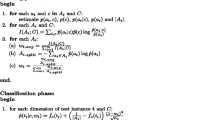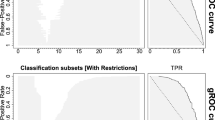Abstract
Naive Bayesian classification has been widely used in data mining area because of its simplicity and robustness to missing values and irrelevant attributes. However, naive Bayes classifiers sometimes show poor performance due to their unrealistic assumption that all attributes are equally important and conditionally independent of each other. In this research, we dispense with the former assumption by proposing a new attribute weighting method. The proposed method considers each attribute as a single classifier and measures its discriminating ability using the area under an ROC curve (AUC). Each AUC value is then used to weight the corresponding attribute. In addition, we try to reduce the complexity of classification models by selecting high AUC attributes. Using 20 real datasets from the machine learning repository at UC Irvine (UCI), we conduct a numerical experiment to show that the proposed method is an improvement over standard naive Bayes classification and existing weighting methods.



Similar content being viewed by others
References
Bradley P (1997) The use of the area under the ROC curve in the evaluation of machine learning algorithms. Pattern Recogn 30(7):1145–1159
Campadelli P, Casiraghi E, Valentini G (2005) Support vector machines for candidate nodules classification. Neurocomputing 68:281–288
Chan PK, Fan W, Prodromidis AL, Stolfo SJ (1999) Distributed data mining in credit card fraud detection. IEEE Intell Syst 14(6):67–74
Chawla NV, Bowyer KW, Hall LO, Kegelmeyer WP (2002) SMOTE: synthetic minority over-sampling technique. J Artif Intell Res 16:321–357
Drummond C, Holte RC (2000) Exploiting the cost (in)sensitivity of decision tree splitting criteria. In: Proceedings of the 17th International Conference on Machine Learning, pp 239–246
Fawcett T (2006) An introduction to ROC analysis. Pattern Recogn Lett 27:861–874
Ferri C, Flach P, Hernandez-Orallo J (2002) Learning decision trees using the area under the ROC Curve. In: Proceedings of the 19th International Conference on Machine Learning, pp 139–146
Guo H, Viktor H (2004) Learning from imbalanced data sets with boosting and data generation: The DataBoost-IM approach. SIGKDD Explor Spec Issue Imbal Data Sets 6:30–39
Guyon I, Elisseeff A (2003) An introduction to variable and feature selection. J Mach Learn Res 3:1157–1182
Hall M (2007) A decision tree-based attribute weighting filter for naive Bayes. Knowl-Based Syst 20(2):120–126
Hanley JA, McNeil BJ (1982) The meaning and use of the area under a receiver operating characteristic (ROC) curve. Radiology 143:29–36
Hassan MR, Hossain MM, Bailey J, Ramamohanarao K (2008) Improving k-nearest neighbour classification with distance functions based on receiver operating characteristics. Lec Notes Comput Sci 5211:489–504
Hossain MM, Hassan MR, Bailey J (2008) ROC-tree: a novel decision tree induction algorithm based on receiver operating characteristics to classify gene expression data. In: Proceedings of SIAM International Conference on Data Mining, pp 455–465
Japkowicz N, Stephen S (2002) The class imbalance problem: a systematic study. Intell Data Anal 6(5):429–449
Langley P, Sage S (1994) Induction of selective Bayesian classifiers. In: Proceedings of 10th International Conference on Uncertainty in Artificial Intelligence, pp 399–406
Lee CH, Gutierrez F, Dou D (2011) Calculating feature weights in naive Bayes with Kullback-Leibler measure. In: Proceedings of the 11th IEEE International Conference on Data Mining, pp 1146–1151
Lee JS, Zhu D (2011) When costs are unequal and unknown: a subtree grafting approach for unbalanced data classification. Decision Sci 42(4):803–829
Liu XY, Wu J, Zhou ZH (2009) Exploratory undersampling for class-imbalance learning. IEEE Trans Syst Man Cybern Part B Cybern 39(2):539–550
Tan PN, Steinbach M, Kumar V (2006) Introduction to data mining. Addison Wesley, Boston
Tang Y, Krasser S, Alperovitch D, Judge P (2008) Spam sender detection with classification modeling on highly imbalanced mail server behavior data. In: Proceedings of International Conference on Artificial Intelligence and Pattern Recognition, pp 174–180
UCI Repository of Machine Learning Databases. University of California, Irvine, CA. http://www.ics.uci.edu/~mlearn/MLRepository.html/
Weiss GM, McCarthy K, Zabar B (2007) Cost-sensitive learning vs. sampling: which is best for handling unbalanced classes with unequal error costs? In: Proceedings of 2007 International Conference on Data Mining, pp 35–41
Wu J, Cai Z (2011) Attribute weighting via differential evolution algorithm for attribute weighted naive Bayes (WNB). J Comput Inform Syst 7(5):1672–1679
Yen SJ, Lee YS (2009) Cluster-based under-sampling approaches for imbalanced data distributions. Expert Syst with Appl 36(3):5718–5727
Zhang G, Berardi VL (1998) An investigation of neural networks in thyroid function diagnosis. Health Care Manage Sci 1(1):29–37
Zhang H, Sheng S (2004) Learning weighted naive Bayes with accurate ranking. In: Proceedings of the 4th IEEE International Conference on Data Mining, pp 567–570
Acknowledgments
This research was supported by the MSIP, Korea, under the G-ITRC support program (IITP-2015-R6812-15-0001) supervised by the IITP.
Author information
Authors and Affiliations
Corresponding author
Rights and permissions
About this article
Cite this article
Kim, T., Chung, B.D. & Lee, JS. Incorporating receiver operating characteristics into naive Bayes for unbalanced data classification. Computing 99, 203–218 (2017). https://doi.org/10.1007/s00607-016-0483-z
Received:
Accepted:
Published:
Issue Date:
DOI: https://doi.org/10.1007/s00607-016-0483-z




